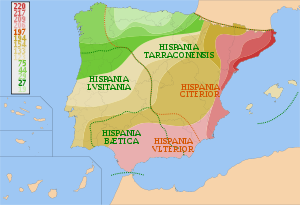This article needs additional citations for verification. (February 2022) |
Year 309 (CCCIX) was a common year starting on Saturday (link will display the full calendar) of the Julian calendar. In the Roman Empire, it was known as the Year of the Consulship of Licinianus and Constantius[1] (or, less frequently, year 1062 Ab urbe condita). The denomination 309 for this year has been used since the early medieval period, when the Anno Domini calendar era became the prevalent method in Europe for naming years.
| Millennium: | 1st millennium |
|---|---|
| Centuries: | |
| Decades: | |
| Years: |
| Gregorian calendar | 309 CCCIX |
| Ab urbe condita | 1062 |
| Assyrian calendar | 5059 |
| Balinese saka calendar | 230–231 |
| Bengali calendar | −284 |
| Berber calendar | 1259 |
| Buddhist calendar | 853 |
| Burmese calendar | −329 |
| Byzantine calendar | 5817–5818 |
| Chinese calendar | 戊辰年 (Earth Dragon) 3006 or 2799 — to — 己巳年 (Earth Snake) 3007 or 2800 |
| Coptic calendar | 25–26 |
| Discordian calendar | 1475 |
| Ethiopian calendar | 301–302 |
| Hebrew calendar | 4069–4070 |
| Hindu calendars | |
| - Vikram Samvat | 365–366 |
| - Shaka Samvat | 230–231 |
| - Kali Yuga | 3409–3410 |
| Holocene calendar | 10309 |
| Iranian calendar | 313 BP – 312 BP |
| Islamic calendar | 323 BH – 322 BH |
| Javanese calendar | 189–190 |
| Julian calendar | 309 CCCIX |
| Korean calendar | 2642 |
| Minguo calendar | 1603 before ROC 民前1603年 |
| Nanakshahi calendar | −1159 |
| Seleucid era | 620/621 AG |
| Thai solar calendar | 851–852 |
| Tibetan calendar | 阳土龙年 (male Earth-Dragon) 435 or 54 or −718 — to — 阴土蛇年 (female Earth-Snake) 436 or 55 or −717 |

Events
editBy place
editRoman Empire
edit- Gaius Ceionius Rufius Volusianus, the Praetorian Prefect of Emperor Maxentius, defeats the usurper Domitius Alexander and purges Africa of his supporters.
Persia
edit- King Hormizd II, ruler of the Sassanid Empire, demands that the king of the Ghassanids pays tribute. After the king refuses, Hormizd invades Ghassanid territory. The Ghassanids seek aid from Maximinus Daza, but before a Roman army can arrive, Hormizd defeats the Ghassanid army and kills their king. A Ghassanid force then ambushes Hormizd's small retinue while the latter is on a hunting trip, and the Sasanian king is mortally wounded. He dies after a 7-year reign.[2]
- Hormizd is succeeded by his infant son Shapur II following the brief reign and murder of Adur Narseh.[3]
By topic
editReligion
edit- Pope Marcellus I is banished from Rome by Emperor Maxentius.[4]
- April 18 – Eusebius succeeds Marcellus I as the 31st pope, but is himself banished on August 17 to Sicily (these events may have also taken place in 310).[5]
Births
edit- Shapur II (the Great), king of the Sassanid Empire (d. 379)
Deaths
edit- January 16 – Marcellus I, bishop of Rome (b. 255)
- Adur Narseh, king of the Sassanid Empire
- Elias and companions, Christian martyrs
- Hormizd II, king of the Sassanid Empire
References
edit- ^ Smith, William (1862). A New Classical Dictionary of Greek and Roman Biography, Mythology and Geography (Partly Based Upon the Dictionary of Greek and Roman Biography and Mythology). HarperCollins. p. 1008.
- ^ Bal'ami, Abu Ali. Annals, Chapter 15.
- ^ Smith Williams, Henry (March 16, 2019). The Historians' History of the World. Creative Media Partners. ISBN 9781010421023.
- ^ Johann Joseph Ignaz, von Doellinger; Baur, Ferdinand Christian; Gieseler, Johann Carl Ludwig; Plummer, Alfred; Wordsworth, Christopher (1876). Hippolytus and Callistus: or, the Church of Rome in the first half of the third century. p. 66.
- ^ Bower, Archibald (1844). The History of the Popes: From the Foundation of the See of Rome to A.D. 1758 · Volume 1. Griffith and Simon. p. 41.